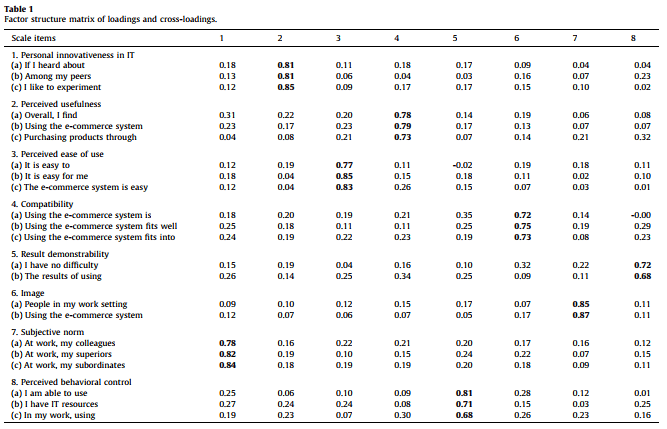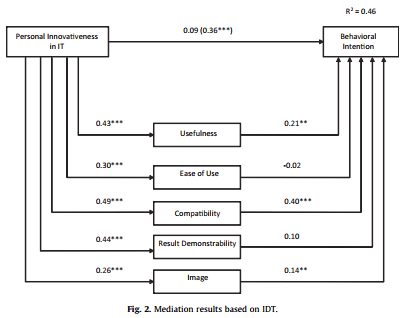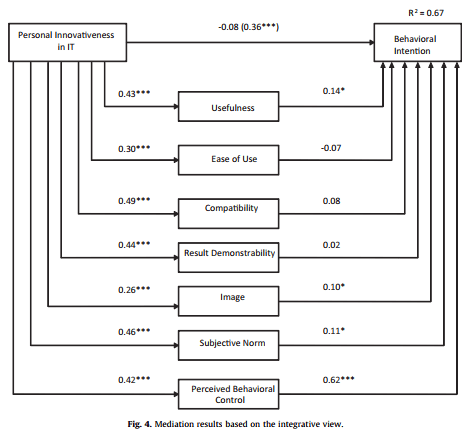ارتباط بین نوآوری شخصی و پذیرش کاربر از تکنولوژی با آزمون عملی مدل های سه واسطه ای


19,500 تومانشناسه فایل: 6904
- حجم فایل ورد: 320.1KB حجم پیدیاف: 375.7KB
- فرمت: فایل Word قابل ویرایش و پرینت (DOCx)
- تعداد صفحات فارسی: 21 انگلیسی: 8
- دانشگاه:
- College of Business Administration, University of Texas-Pan American, USA
- College of Information Science and Technology, Korea Advanced Institute of Science and Technology, Republic of Korea
- Department of Health Care Administration, Kosin University, Republic of Korea
- ژورنال: Information and Management (1)
چکیده
درک محرک های پذیرش تکنولوژی یک مشکل مهم سازمانی است. تحقیق ما بر روی یک ویژگی رفتاری متمرکز است که مرتبط با پذیرش نوآوری های تکنولوژیکی است: نوآوری شخصی در IT (PIIT). ما مسیرهای علی را مورد بررسی قرار دادیم که توسط سه مدل جایگزین مبتنی بر تئوری انتشار نوآوری ،تئوری رفتار برنامهریزی شده و منظری یکپارچه که آن ها را ترکیب می کند، که این ویژگی بر هدف های رفتاری تاثیر می گذارد. داده ها از 196 مدیر بیمارستان در کره جنوبی جمعآوری شده اند. نوآوری هدف، یک سیستم خرید الکترونیکی بود. تست از طریق هر سه مدل منجر به واسطه کامل شد که نشان می دهد نوآوری شخصی در فناوری اطلاعات (PIIT) پیش بینی کننده محکمی برای استفاده هدفمند از IT است، اما تاثیر آن را با جایگزین کردن واسطه ها به اثبات می رساند. چشم انداز یکپارچه ما یک شرح کامل تر برای مکانیسم های علی است که نشان دهنده روابط و نیز بینش های منحصر به فردی است که نمی تواند با یک مدل، مبتنی بر تئوری هدایت شود.
مقدمه مقاله
پذیرش سیستم اطلاعاتی همچنان موضوعی حیاتی است؛ زیرا سیستم ها نمی توانند هیچ مزیتی خلق کنند مگر اینکه استفاده شوند. مشخص شده است که یک عامل کلیدی که پذیرش IT توسط کاربر را زمینه سازی می کند، ویژگی های شخصیتی است و آمادگی قبلی افراد برای پاسخ به محرک در موقعیت های متغیر پیشنهاد شده است [18،7]. یکی از چنین ویژگی هایی که قبلا در پژوهش های گذشته، به صورت تجربی تایید شده است، نوآوری شخصی است. این ویژگی که از تئوری انتشار نوآوری (IDT) نشات می گیرد، یک ویژگی ماندگار است که تقریبا در همه افراد وجود دارد. برخی افراد می پذیرند، در حالی که برخی دیگر نوآوری می کنند. آگاروال و پراساد، استانداردی برای نوآوری شخصی در IT ایجاد کردند: نوآوری شخصی در IT به معنی تمایل به امتحان هر فناوری جدید اطلاعات می باشد [2]. حتی جالبتر این است که چگونه یا به چه وسیلهای یک اثر علّی رخ می دهد؟ سوالات درباره روابط علت و معلولی مفهوم واسطه را می رساند، فرایندی که به وسیله آن برخی متغیرها از طریق متغیرهای واسطه آثاری را بر دیگر متغیرها تحمیل می کنند.
یی و همکاران [22] ماهیت روابط بین PIIT و قصد رفتاری را بررسی کردند تا تعیین کنند که ویژگی های نوآوری شامل مفید بودن، سادگی استفاده و سازگاری، نسبت به قصد رفتاری واسطه است یا تعدیل کننده، که بصورت عملی تایید شد که واسطه می باشد. یافتههای آنها در فهم ما درباره چگونگی ارتباط PIIT با قصد رفتاری، نقش چشمگیری داشت. با این حال، آنها در پژوهش خود از مجموعهای از ویژگی های نوآوری استفاده کردند، در حالی که بر اساس IDT ویژگی های مهم دیگری نیز برای نوآوری وجود دارد.
به علاوه، سوالات بدون پاسخ نیز وجود دارند. نظریه انتشار نوآوری بر فرایندهای اجتماعی و پیش فرضهایی استوار است که ارتباطات بین فردی بر رفتار یک شخص، در حین فرایند پذیرش، اثر می گذارد. علاوه بر این، پذیرندگان اولیه تمایل دارند نسبت به پذیرندگان بعدی اعتماد بنفس بیشتری داشته و کم اشتباه تر باشند [14]. چنین مشاهداتی نشان می دهد که عوامل کنترل فردی و اجتماعی عناصری اضافی هستند که می توانند مسیرهای علی از PIIT به قصد رفتاری را روشن کنند. دو مدل تئوری که این دو عامل را لحاظ می کنند، نظریه رفتار برنامه ریزی شده (TBP) [1] و تئوری واحد پذیرش و استفاده از تکنولوژی [2] هستند. در TBP، عوامل اجتماعی توسط ساختارهای هنجاری ذهنی نمایش داده می شوند، در حالی که UTAUT از ساختار تاثیر اجتماعی برای نشان دادن عوامل اجتماعی استفاده می کند. عوامل کنترل شخصی در TPB و UTAUT به ترتیب توسط کنترل رفتاری ادراک شده و سازه های شرایط تسهیل کننده نشان داده می شوند.
هدف پژوهش ما مقایسه و معتبر ساختن اثر دیدگاههای نظری دیگر به منظور شرح چگونگی تاثیر PIIT بر قصد رفتاری است که به موجب آن بتواند بطور کامل تری نقشی را که PIIT در اثرگذاری بر پذیرش تکنولوژی توسط کاربر دارد، محاسبه نماید. به طور خاصتر، ما بررسی می کنیم که چگونه تاثیر PIIT بر قصد رفتاری در میان منظر IDT، TPB / UTAUT واقع می شود و چگونه آن ها با هم یکپارچه می شوند. انجام این کار می تواند به ما کمک کند که تعیین کنیم کدام دیدگاه نظری شرح کامل تری برای این پدیده ارائه می کند و اینکه آیا ماهیت این رابطه در میان منظرهای نظری رقیب ثابت است یا خیر. تحقیق ما آثار واسطهای سازههای IDT و TPB / UTAUT را بر PIIT بررسی می کند. ما نتایج آن دو مدل را ارزیابی کردیم و مدل سومی را تدوین و آزمون کردیم که سازه هایی را از هر دو تئوری یکی می کند.
[1] theory of planned behavior (TPB)
[2] unified theory of acceptance and use of technology (UTAUT)
ABSTRACT An empirical test of three mediation models for the relationship between personal innovativeness and user acceptance of technology
Understanding the drivers of technology adoption remains an important organizational problem. Our research focused on a personality trait that is relevant to the adoption of technological innovation: personal innovativeness in IT (PIIT). We examined the causal pathways by which this trait affects behavioral intention by testing three alternative models based on innovation diffusion theory, the theory of planned behavior, and an integrative perspective that combines them. Data were collected from 196 hospital administrators in South Korea. The target innovation was an e-commerce purchasing system. Testing across all three models resulted in complete mediation, indicating that PIIT is a strong predictor of intended use of IT but it exerts its influence by altering the mediators. Our integrative perspective provides a more complete account of the causal mechanisms underlying the relationships as well as unique insights that cannot be obtained with a single theory driven model.
Introduction
The acceptance of IS remains a critical issue as systems cannot generate any benefit unless they are used. A key factor that underlies user acceptance of IT has been suggested to be personality traits – individuals’ predisposition to respond to stimuli across varying situations [7,18]. One such personality trait that has a history of empirical support in several research domains is personal innovativeness. Derived from innovation diffusion theory (IDT), personal innovativeness is an enduring trait, possessed by almost everyone. Some adapt while others innovate. Agarwal and Prasad created a metric for individual innovativeness in IT: personal innovativeness in IT (PIIT), defined as willingness to try any new IT [2]. Of even more interest is how or by what means does a causal effect occur? Questions about cause–effect relationships convey the notion of mediation, the process by which some variables exert influences on others through mediating variables.
Yi et al. [22] investigated the nature of the relationship between PIIT and behavioral intention to determine whether the effect of PIIT on behavioral intention would be mediated or moderated by the innovation characteristics of usefulness, ease of use, and compatibility, confirming empirically that the effect was mediated by such characteristics. Their findings were significant in advancing our understanding of how PIIT is related to behavioral intention; however, their study used a limited set of innovation characteristics while, according to IDT, there are other important innovation characteristics. Furthermore, additional unanswered questions remain. The theory of innovation diffusion rests upon social processes and presupposes that interpersonal communication influences the behavior of an individual during the adoption process. Moreover, early adopters tend to be more self-confident and less fatalistic than later adopters [14]. Such observations suggest that social and personal control factors are additional elements that could further illuminate the causal pathways from PIIT to behavioral intention.
Two theoretical models incorporating those two factors are the theory of planned behavior (TPB) and the unified theory of acceptance and use of technology (UTAUT). In TPB, social factors are represented by the subjective norm construct while UTAUT uses the social influence construct to represent social factors. Personal control factors are represented by the perceived behavioral control and facilitating conditions constructs of TPB and UTAUT, respectively.
The purpose of our research was to compare and validate the efficacy of alternative theoretical perspectives in order to explain how the effect of PIIT on behavioral intention is mediated, thereby providing a more complete account of the role PIIT plays in affecting user acceptance of a technology. More specifically, we examined how the effect of PIIT on behavioral intention is mediated from the perspectives of IDT, TPB/UTAUT, and their integration. Doing so can help us determine which theoretical perspective provides a more complete explanation of the phenomena and whether the nature of the relationship is constant across the competing theoretical perspectives. Our research examined the meditation effects of IDT and TPB/UTAUT constructs on the PIIT. We assessed the results of those two models, and developed and tested a third model that integrates constructs from both theories.




- مقاله درمورد ارتباط بین نوآوری شخصی و پذیرش کاربر از تکنولوژی با آزمون عملی مدل های سه واسطه ای
- تاثیر PIIT بر قصد رفتاری در میان منظر IDT، TPB/ UTAUT
- آزمون تجربی سه مدل میانجی برای رابطه بین نوآوری شخصی و پذیرش کاربر از تکنولوژی
- پروژه دانشجویی ارتباط بین نوآوری شخصی و پذیرش کاربر از تکنولوژی با آزمون عملی مدل های سه واسطه ای
- آزمون سه مدل واسطه برای ارتباط بین نوآوری شخصی و پذیرش کاربر از تکنولوژی
- پایان نامه در مورد ارتباط بین نوآوری شخصی و پذیرش کاربر از تکنولوژی با آزمون عملی مدل های سه واسطه ای
- تحقیق درباره ارتباط بین نوآوری شخصی و پذیرش کاربر از تکنولوژی با آزمون عملی مدل های سه واسطه ای
- مقاله دانشجویی ارتباط بین نوآوری شخصی و پذیرش کاربر از تکنولوژی با آزمون عملی مدل های سه واسطه ای
- ارتباط بین نوآوری شخصی و پذیرش کاربر از تکنولوژی با آزمون عملی مدل های سه واسطه ای در قالب پاياننامه
- پروپوزال در مورد ارتباط بین نوآوری شخصی و پذیرش کاربر از تکنولوژی با آزمون عملی مدل های سه واسطه ای
- گزارش سمینار در مورد ارتباط بین نوآوری شخصی و پذیرش کاربر از تکنولوژی با آزمون عملی مدل های سه واسطه ای
- گزارش کارورزی درباره ارتباط بین نوآوری شخصی و پذیرش کاربر از تکنولوژی با آزمون عملی مدل های سه واسطه ای
